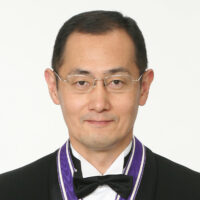
2010 Kyoto Prize Laureates
Biotechnology and Medical Technology
/ Medical Scientist
1962 -
Professor, Kyoto University
New Medical Science Arising from iPS Cells
2010
11 /11 Thu
Place:Kyoto International Conference Center
Perspective of iPS Cells: Principles of Mechanism and Application to Regenerative Medicine
2010
11 /12 Fri
13:30 - 17:20
Place:Kyoto International Conference Center
By introducing just four transcription factor genes into dermal fibroblasts, Dr. Yamanaka succeeded in producing induced pluripotent stem (iPS) cells, which exhibit a pluripotency similar to that of embryonic stem (ES) cells. The iPS cell technology is now expected not only to expand the possibilities of regenerative medicine, but also to make significant contributions to the rapid progress of medical science in general.
By introducing just four transcription factor genes into dermal fibroblasts, Dr. Shinya Yamanaka succeeded in creating induced pluripotent stem (iPS) cells, which exhibit a pluripotency similar to that of embryonic stem (ES) cells. The iPS cell technology is now expected not only to expand the possibilities of regenerative medicine, but also to make significant contributions to the rapid progress of medical science in general.
ES cells are also expected to offer high potential in regenerative medicine, but they are neither without ethical concerns about the destruction of human embryos, nor free from a risk of immunological rejection.
If a differentiated cell nucleus is transplanted into an enucleated ovum, the expression profile of the genome is reprogrammed into a non-differentiated state. This vital phenomenon has long been recognized, but no one could have foreseen that such a limited number of factors were responsible for this complicated process.
Dr. Yamanaka approached his research from the hypothesis that factors maintaining the pluripotency of ES cells may be able to reprogram a differentiated cell back into a pluripotent state. Utilizing an open database, he identified dozens of genes expressed specifically in ES cells. After carrying out numerous experiments on such genes, he finally succeeded in generating iPS cells with the capacity for self-renewal and pluripotency similar to that of ES cells by introducing four genes (Oct3/4, Sox2, Klf4, c-Myc) into dermal fibroblast cells of mice. Dr. Yamanaka’s research group then went on to generate iPS cells from human fibroblasts using a similar technique.
Dr. Yamanaka’s series of research is extremely original and innovative in that he made it possible to turn back the clock to induce self-renewing pluripotent stem cells from differentiated somatic cells by introducing a small number of transcription factor genes. The iPS cell technology is expected to enable elucidation of the pathologies of intractable diseases and their cures, as well as screening for drug discovery and toxicity tests, thereby making immense contributions to the advancement of not only regenerative medicine, but to the field of medical science as a whole.
For these reasons, the Inamori Foundation is pleased to present the 2010 Kyoto Prize in Advanced Technology to Dr. Shinya Yamanaka.
Profile is at the time of the award.